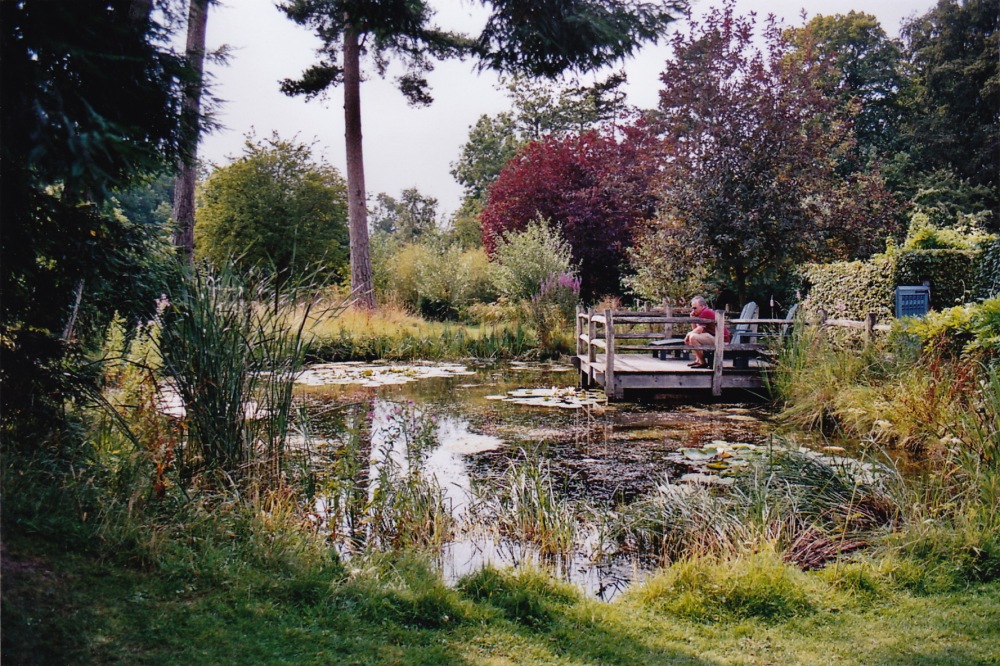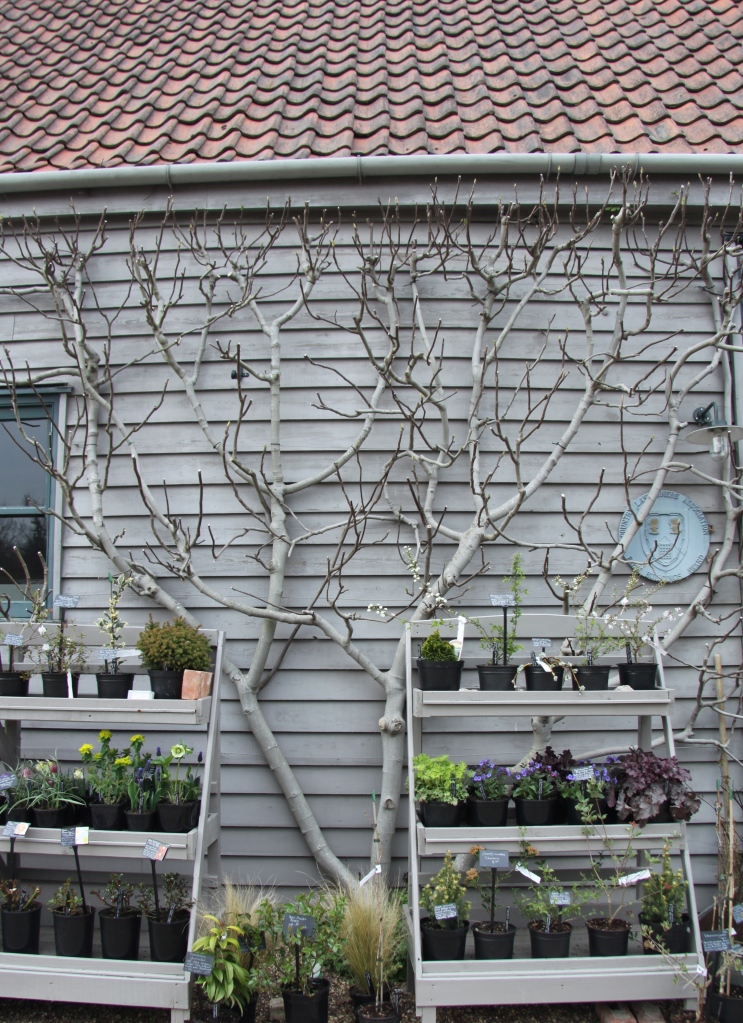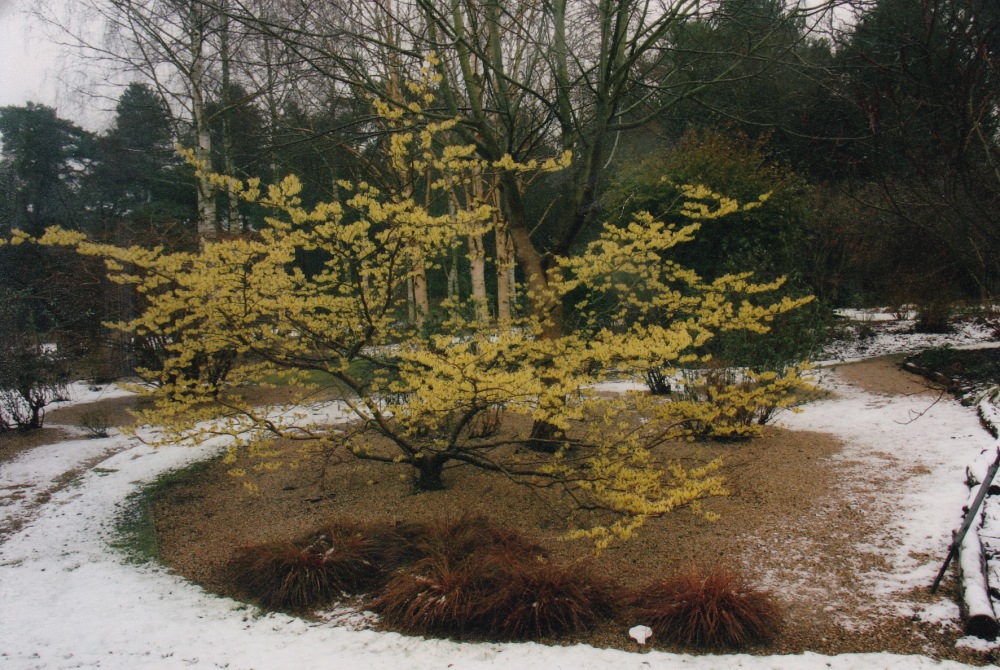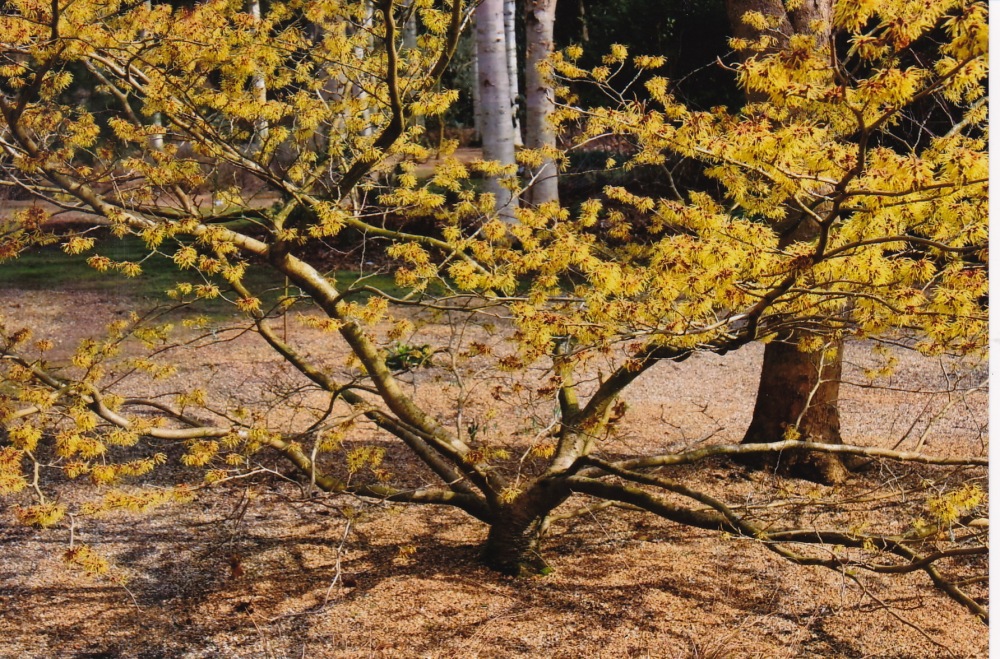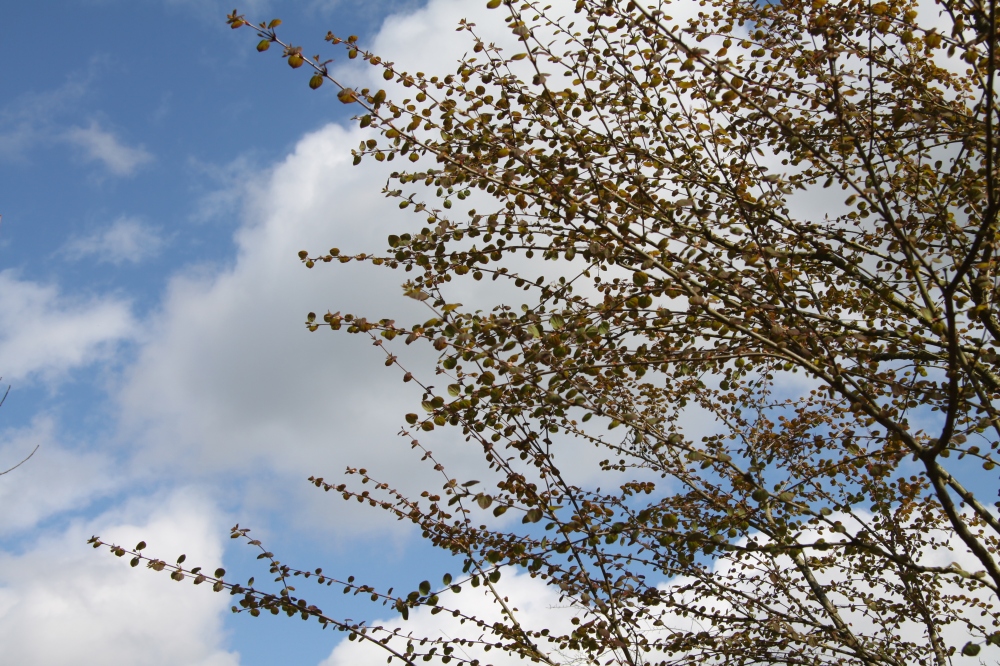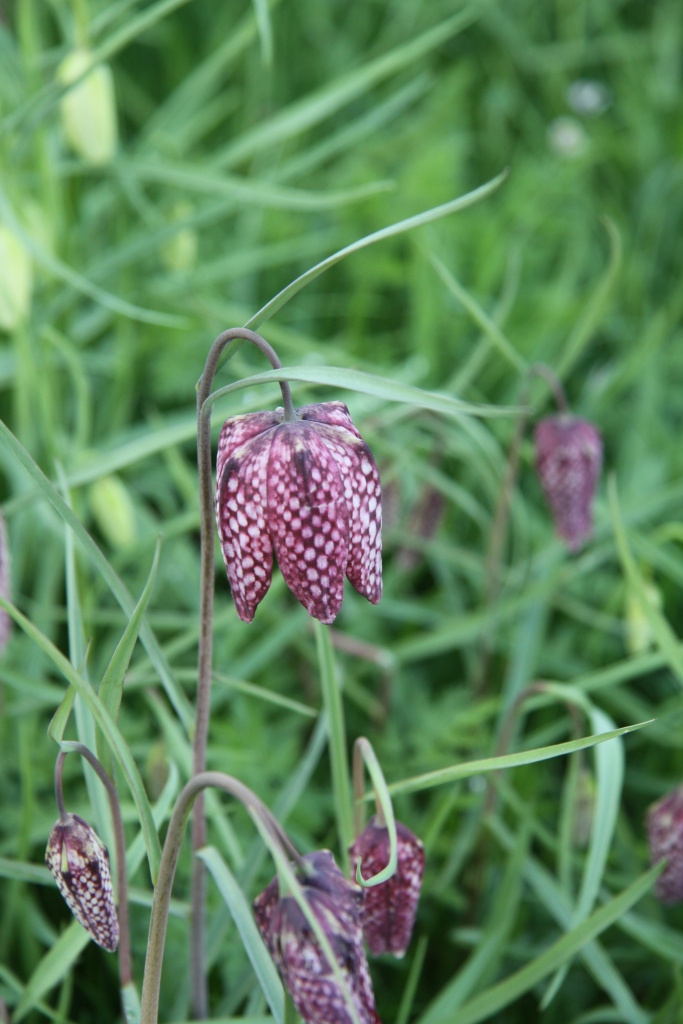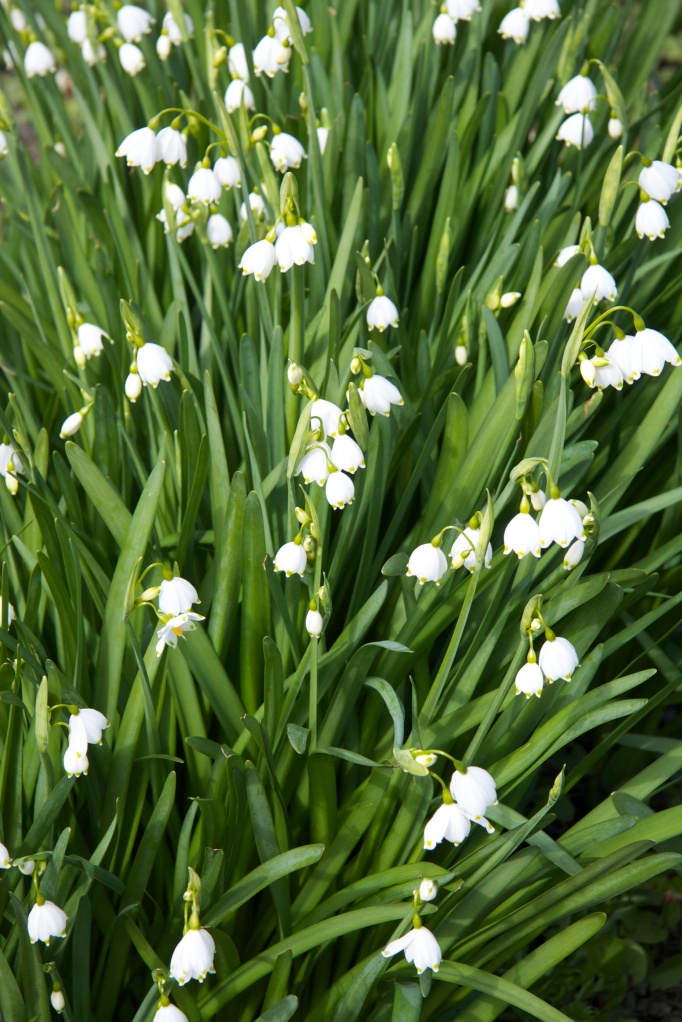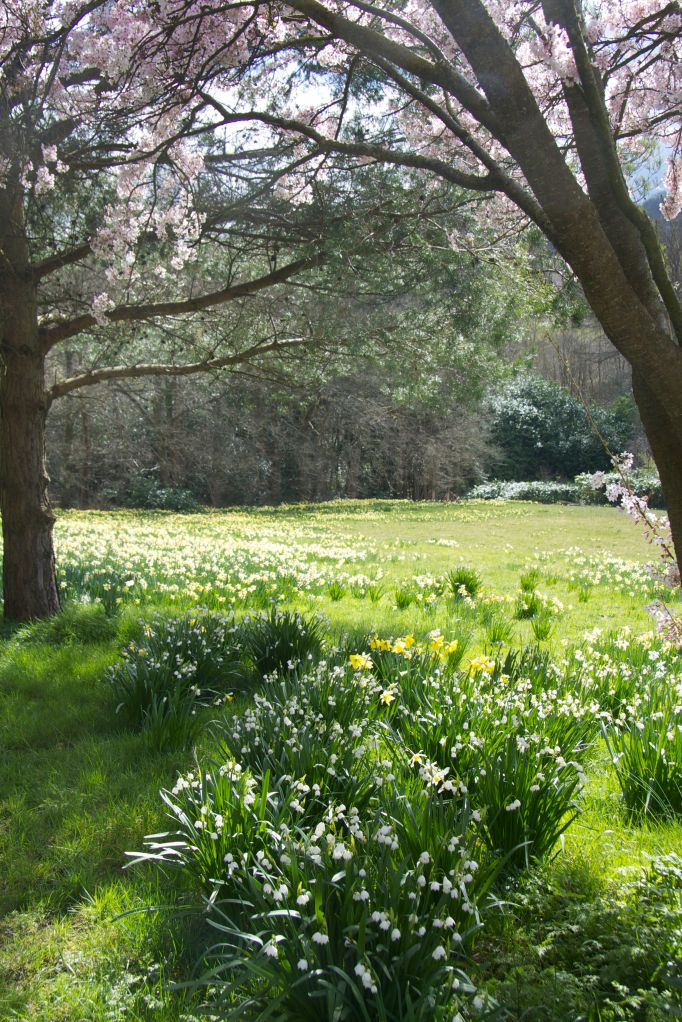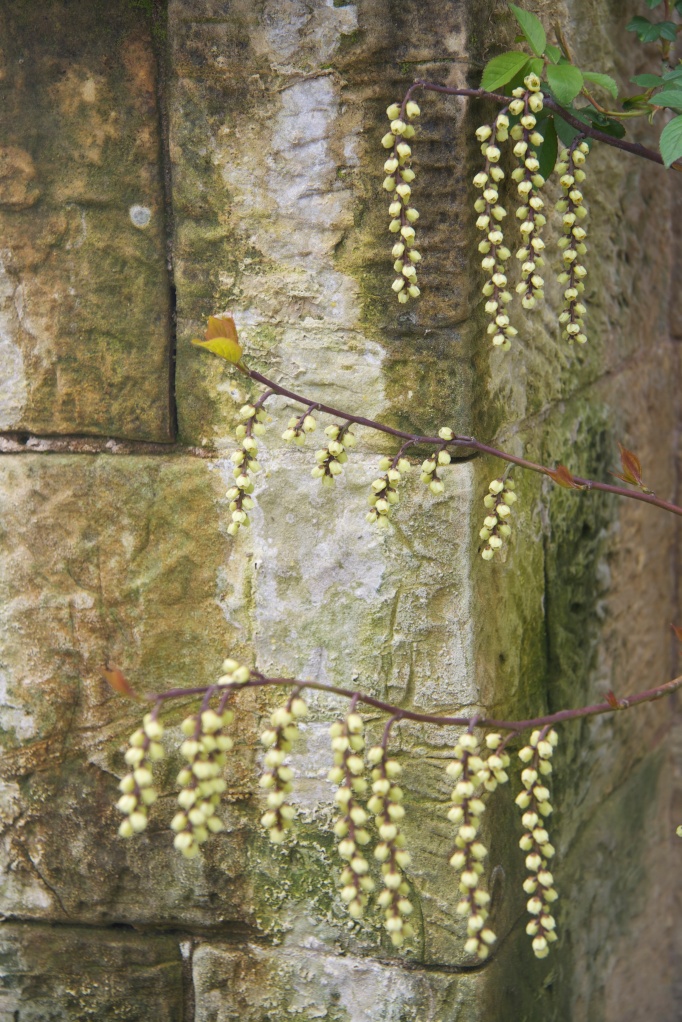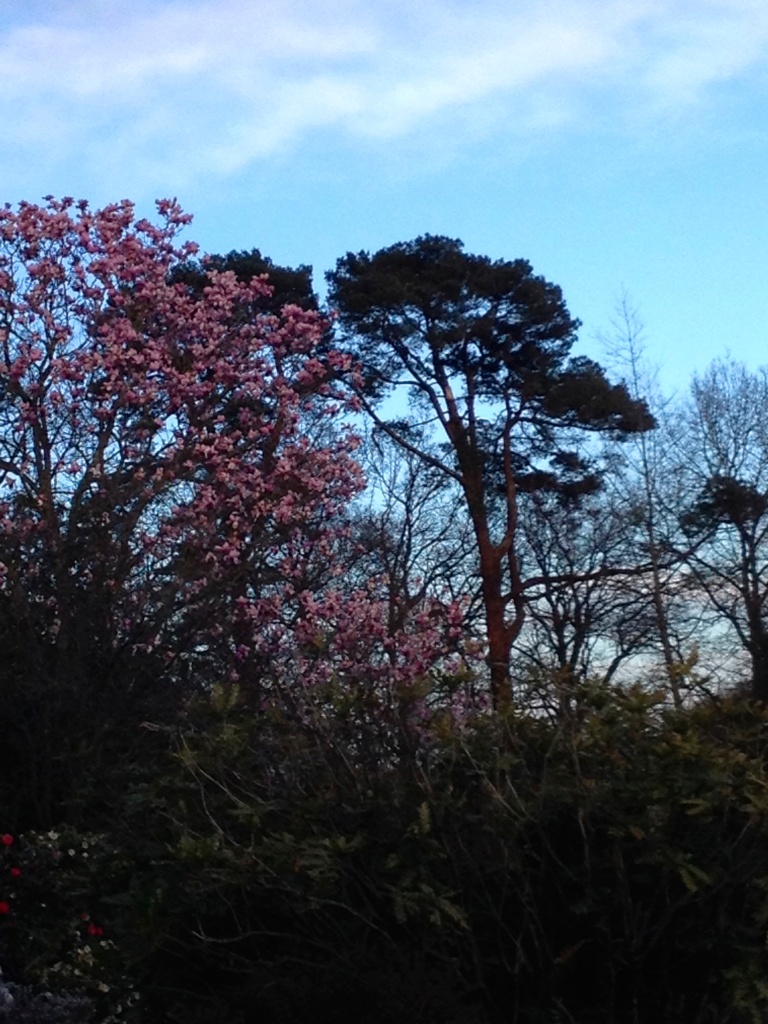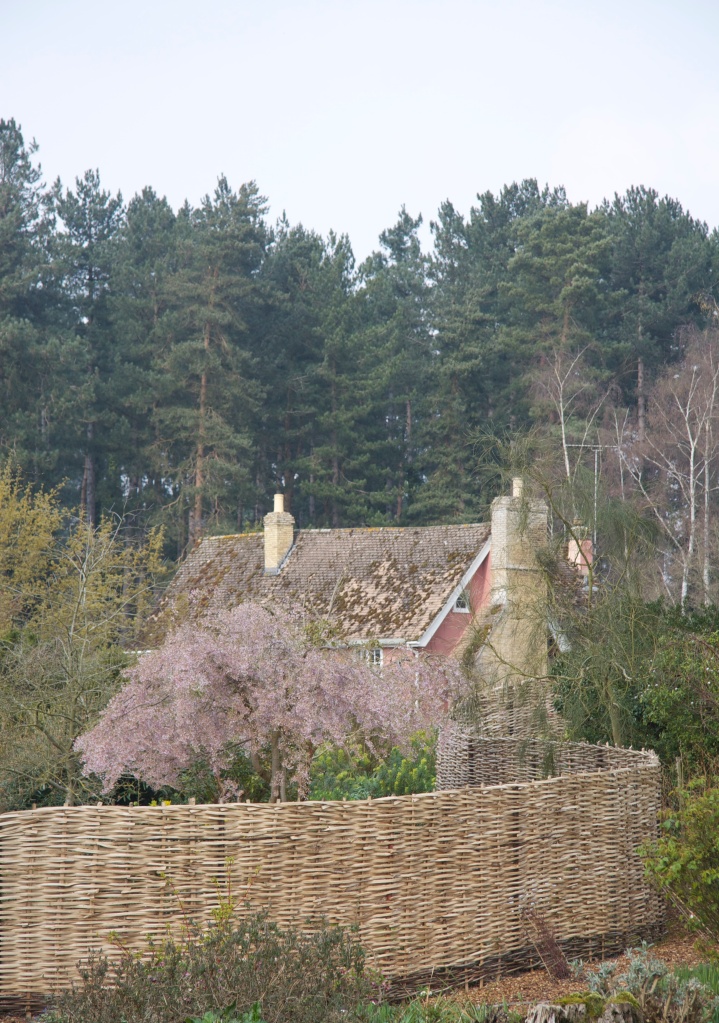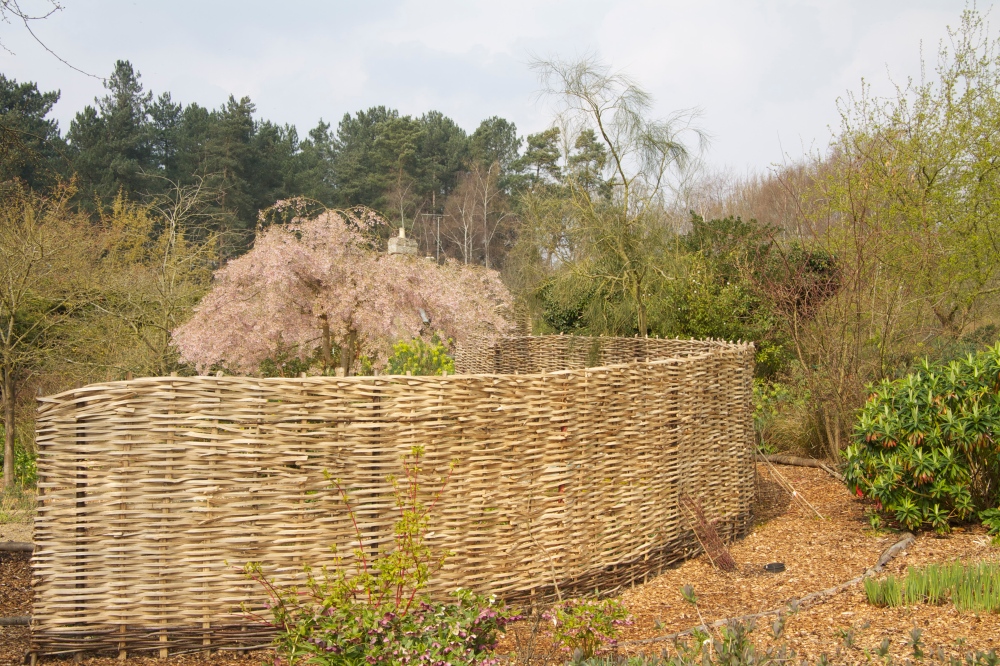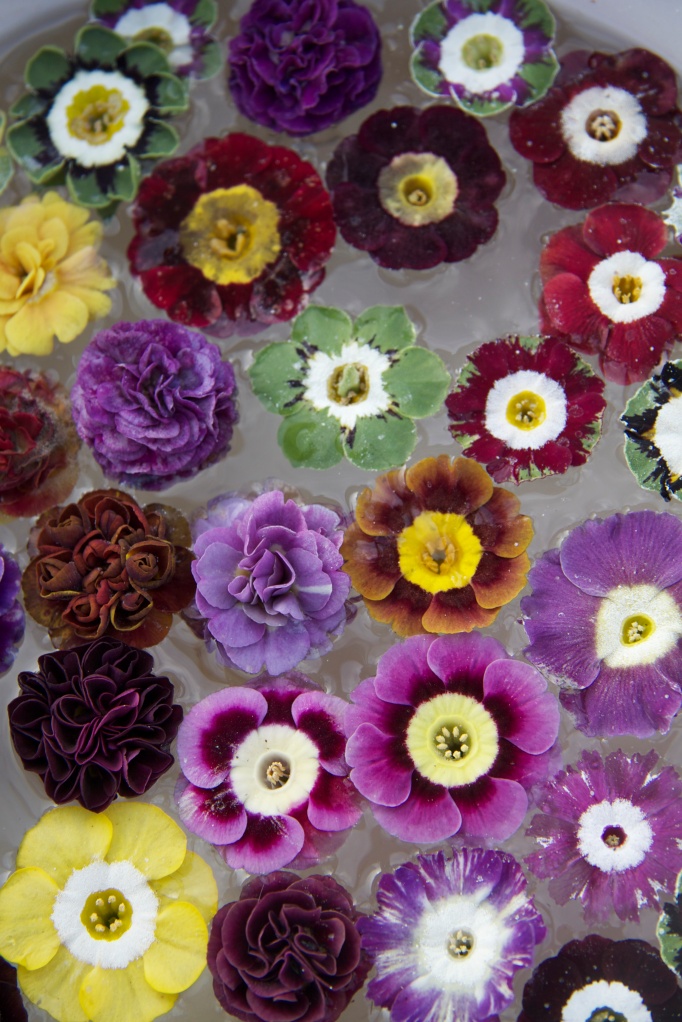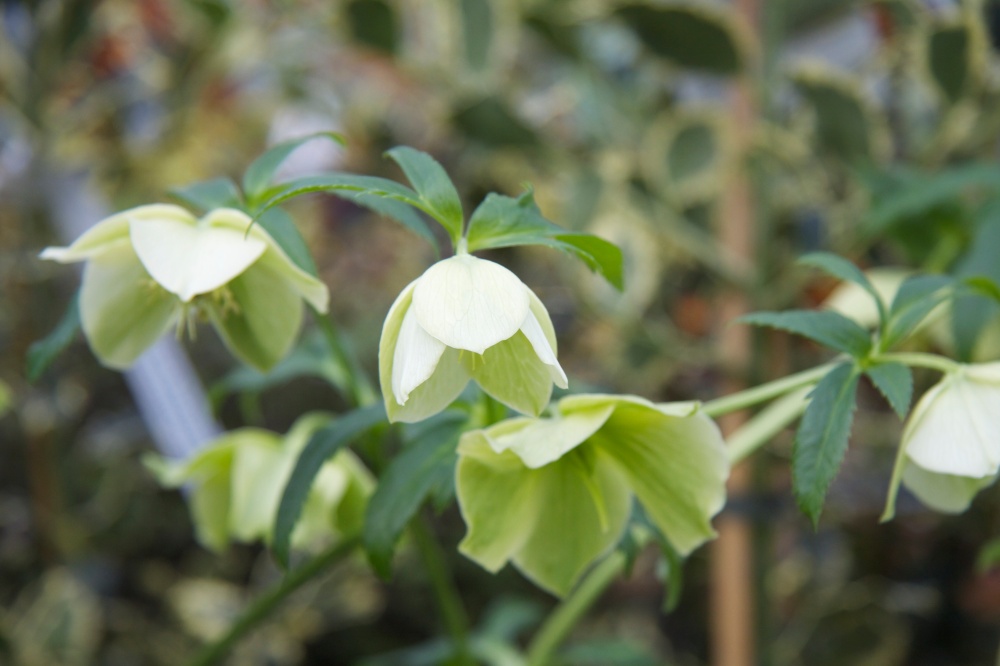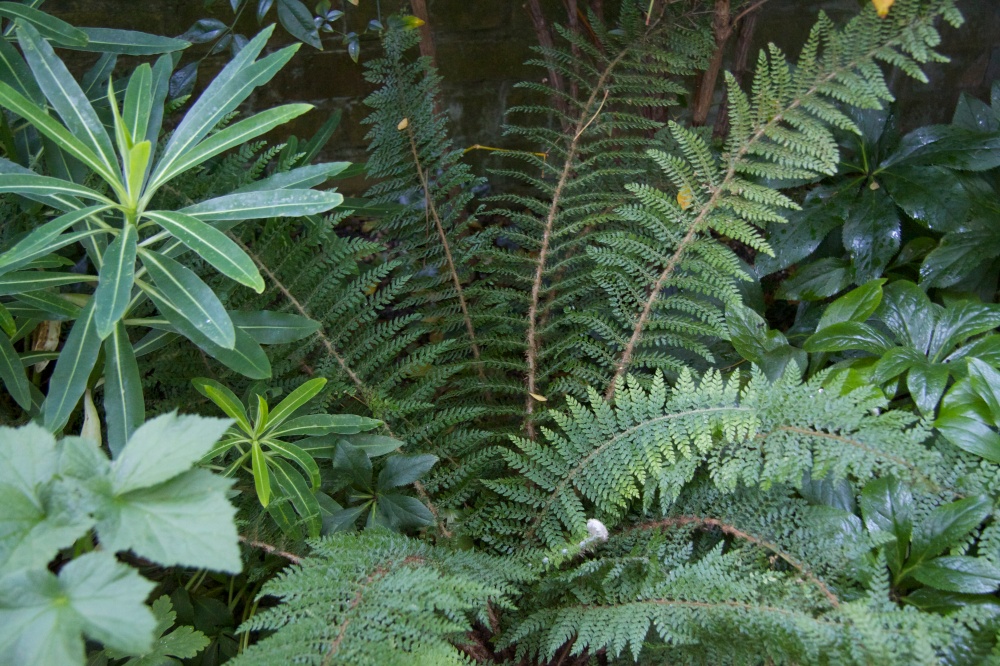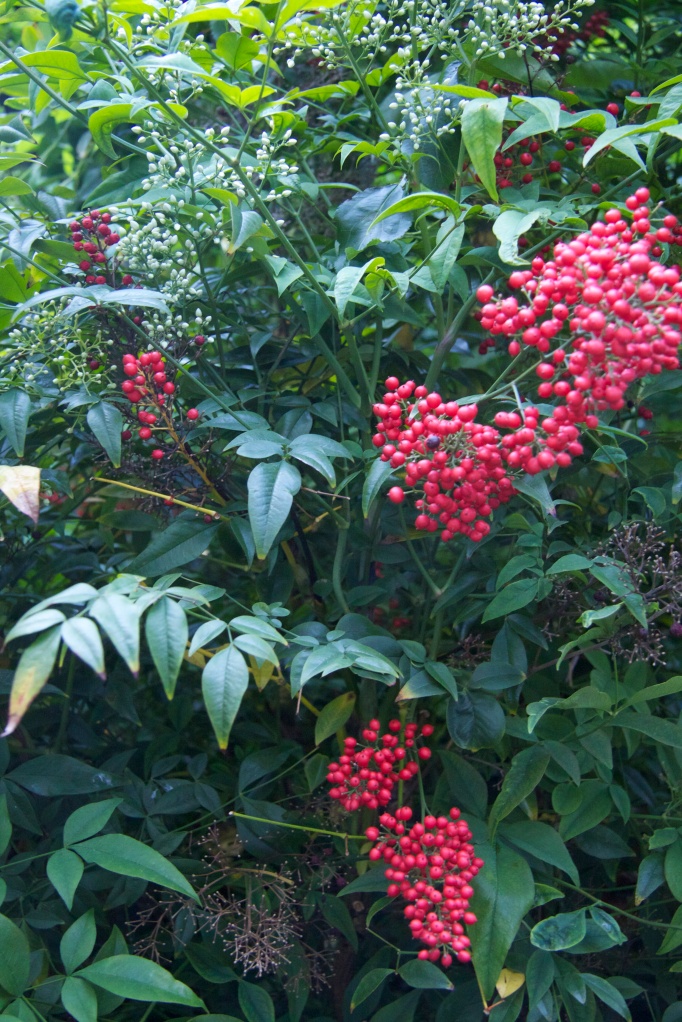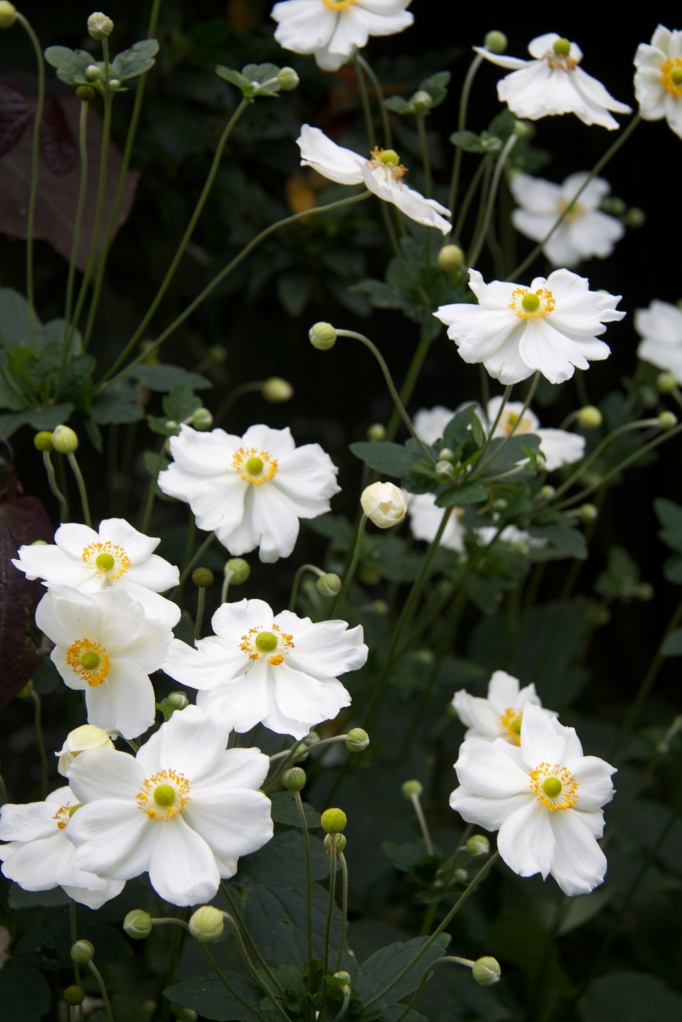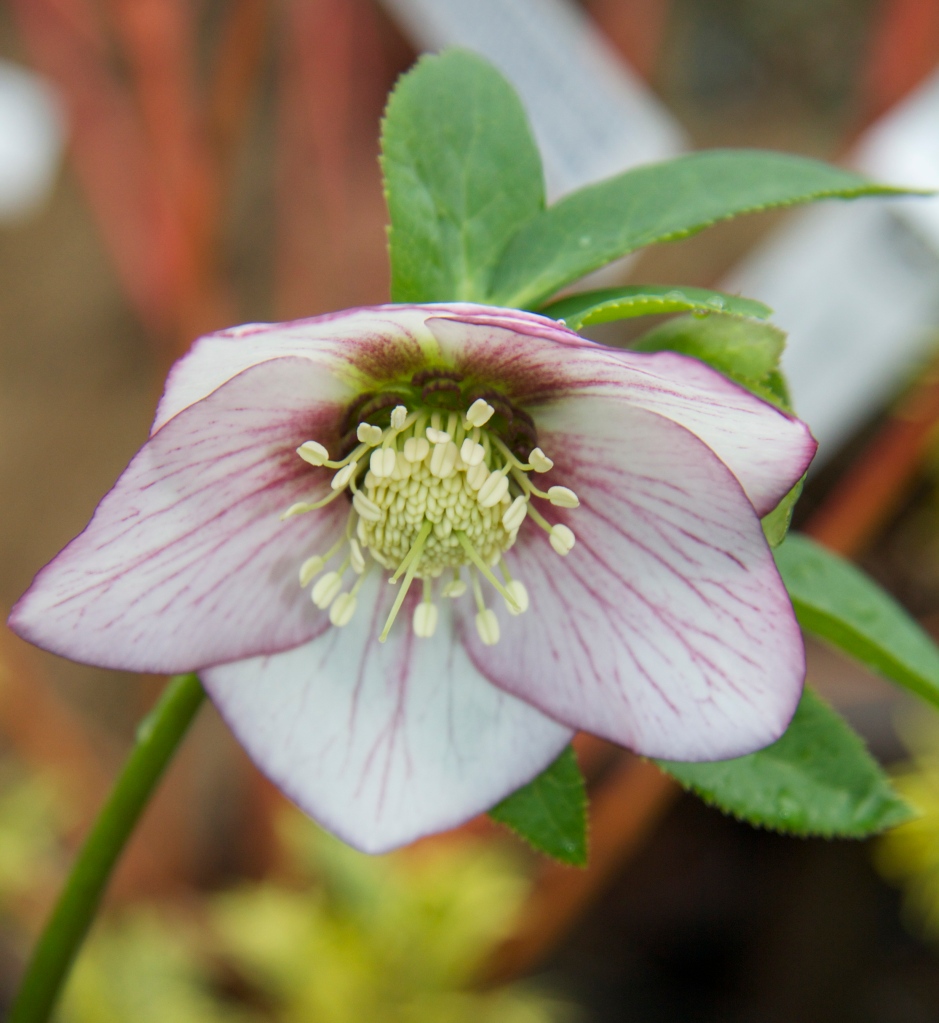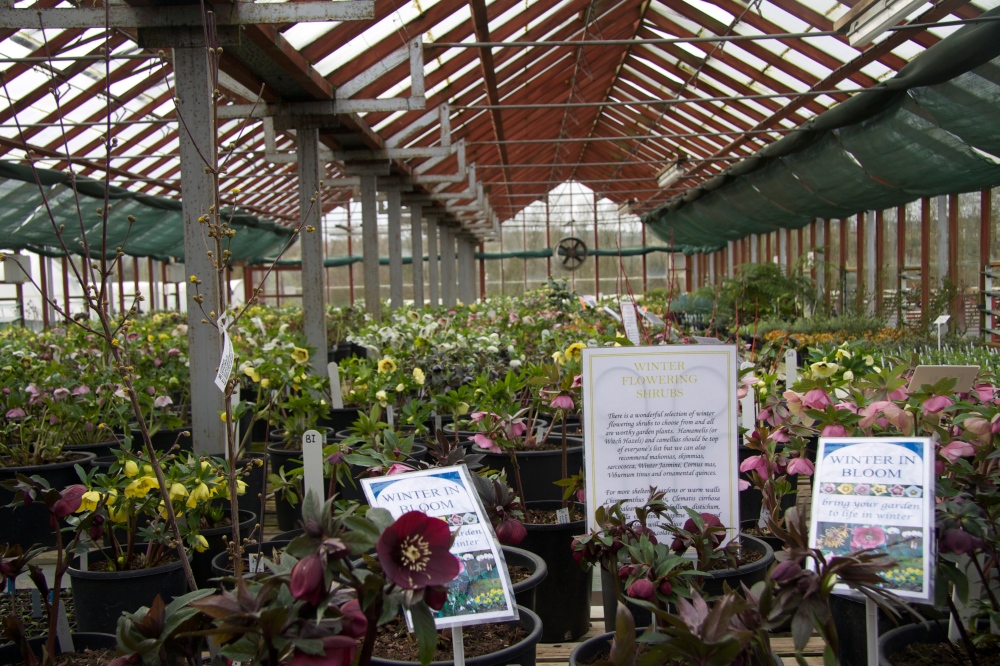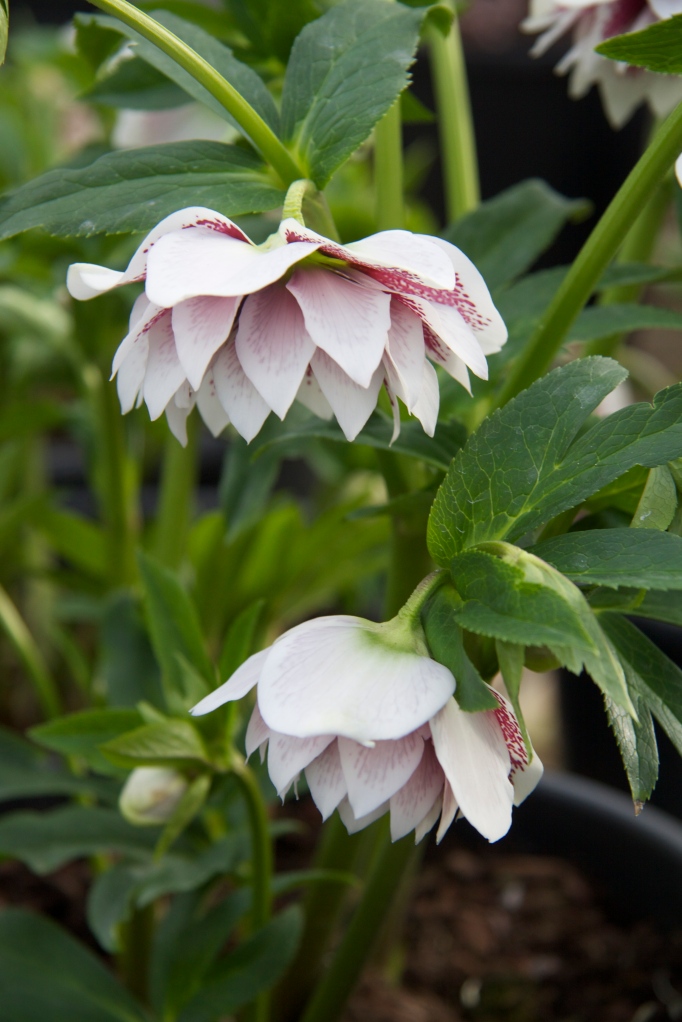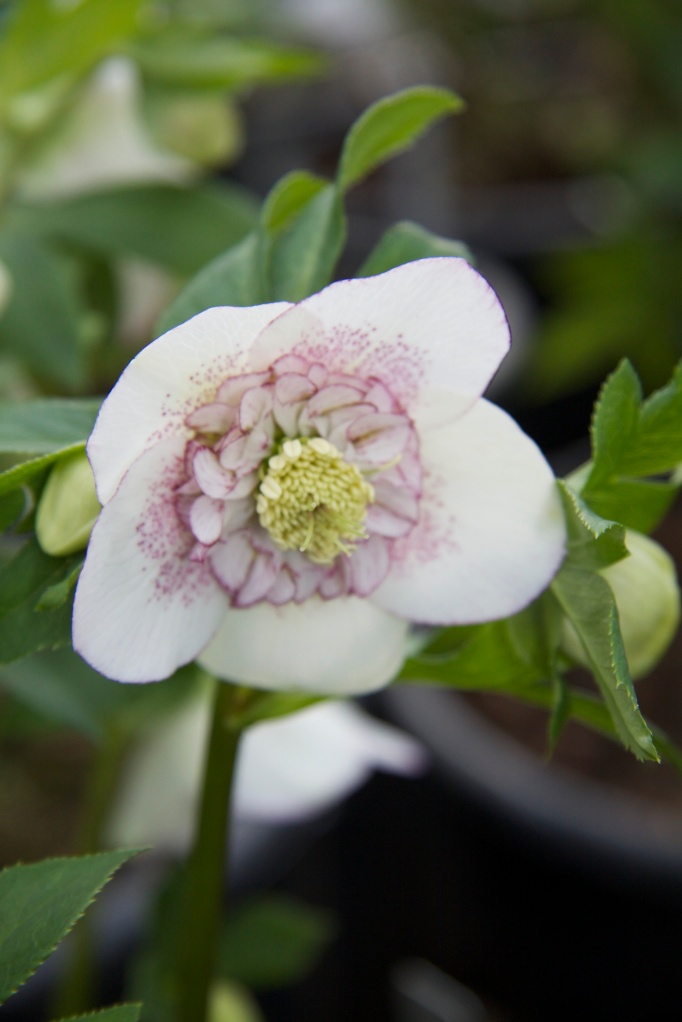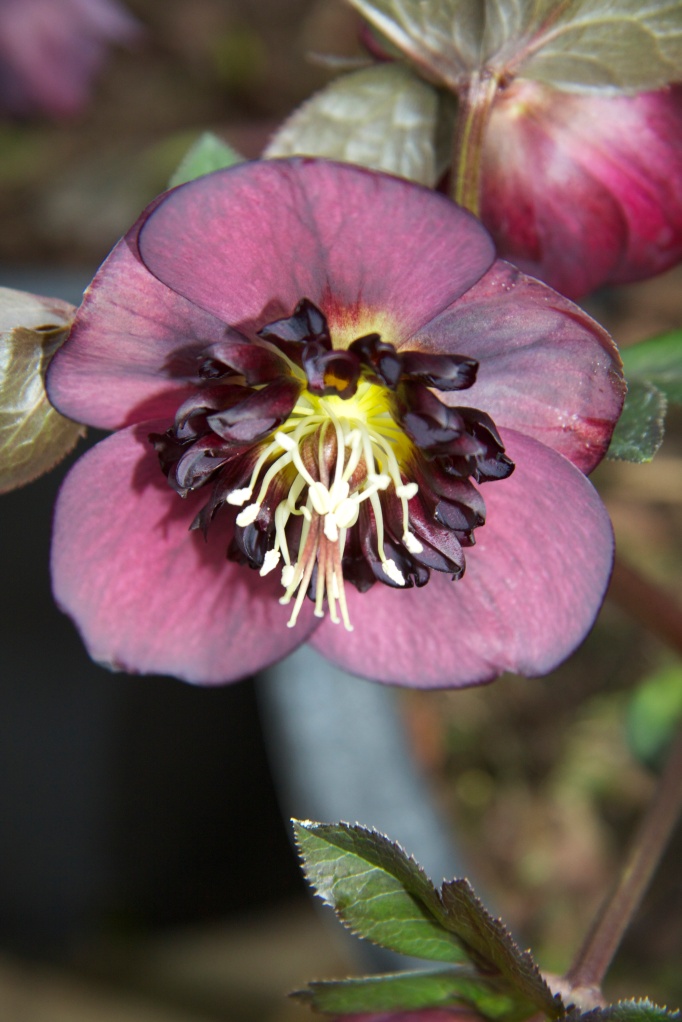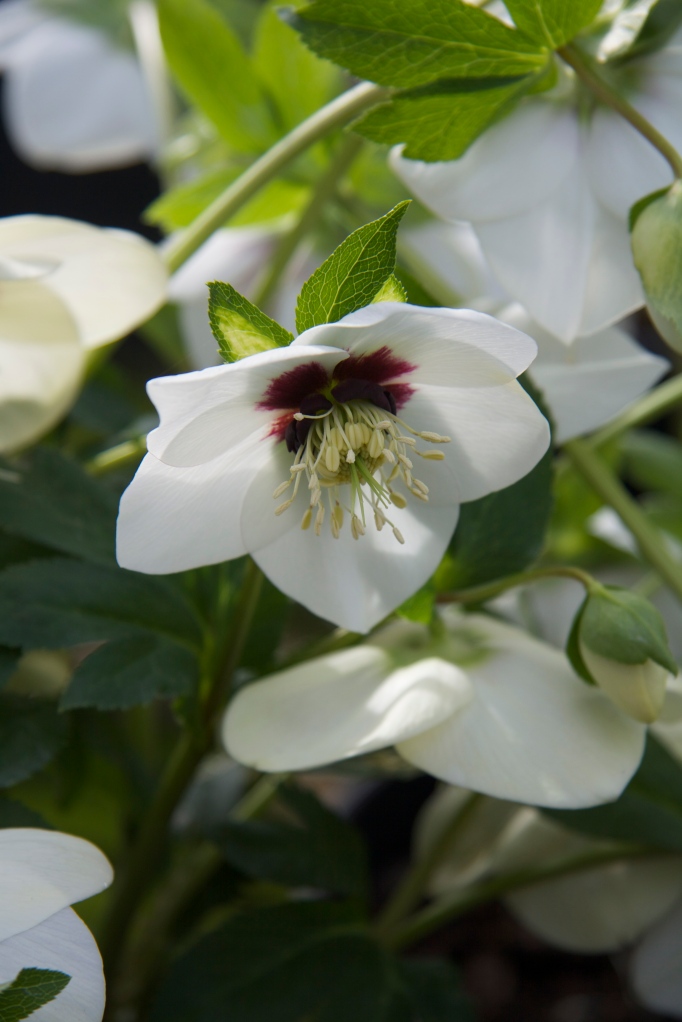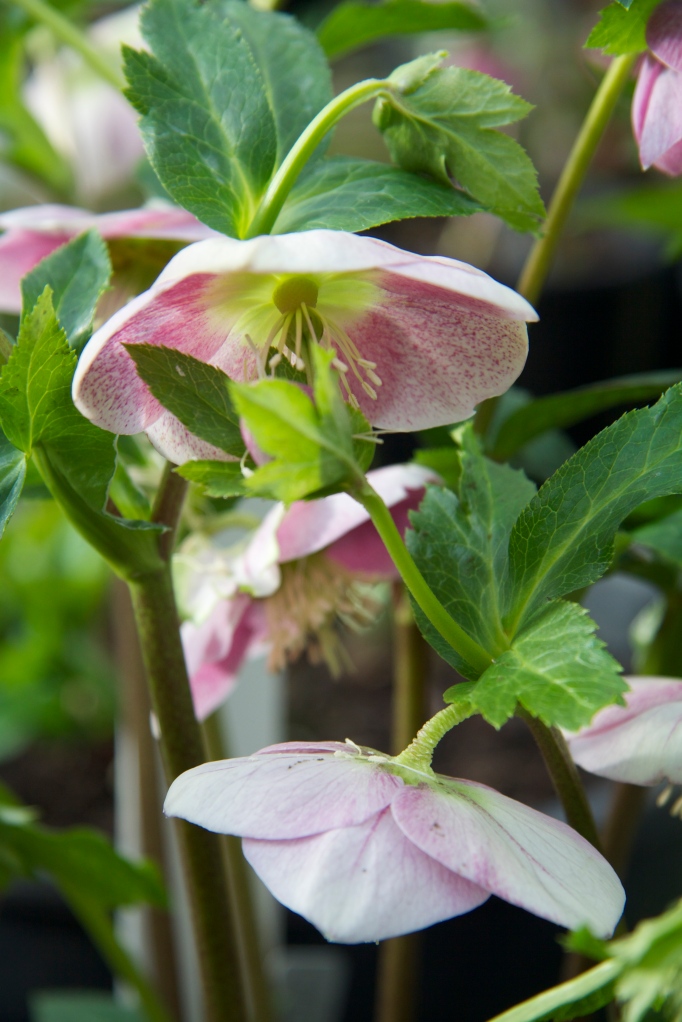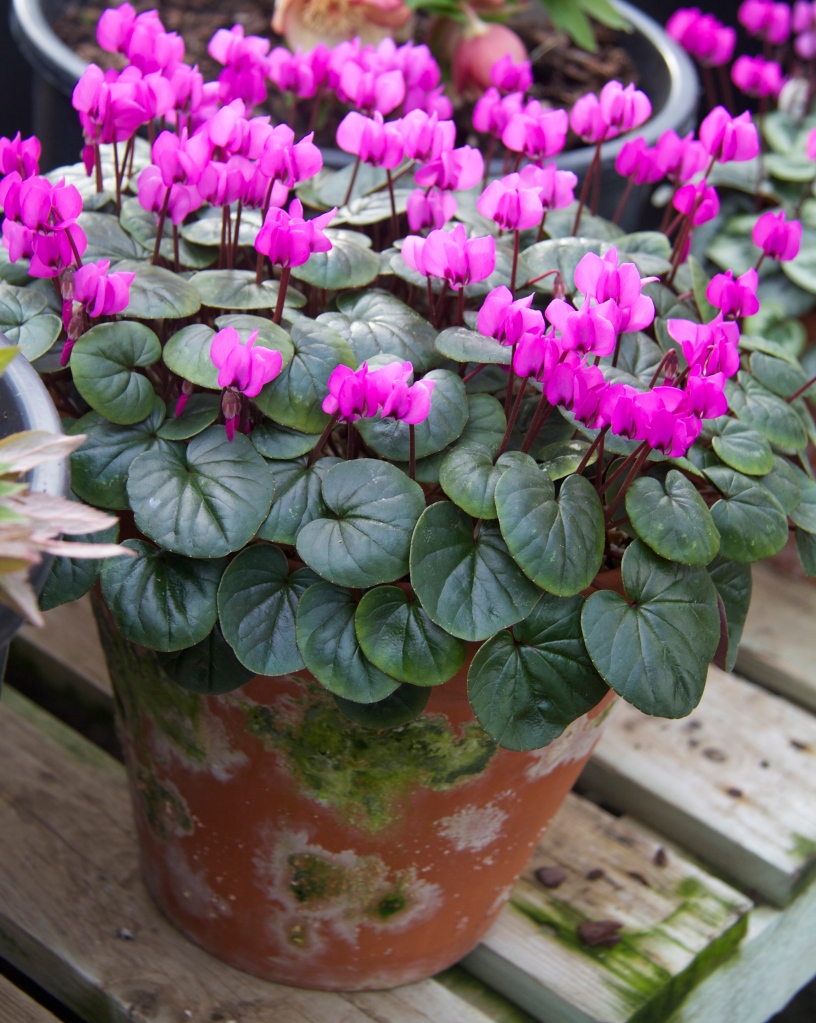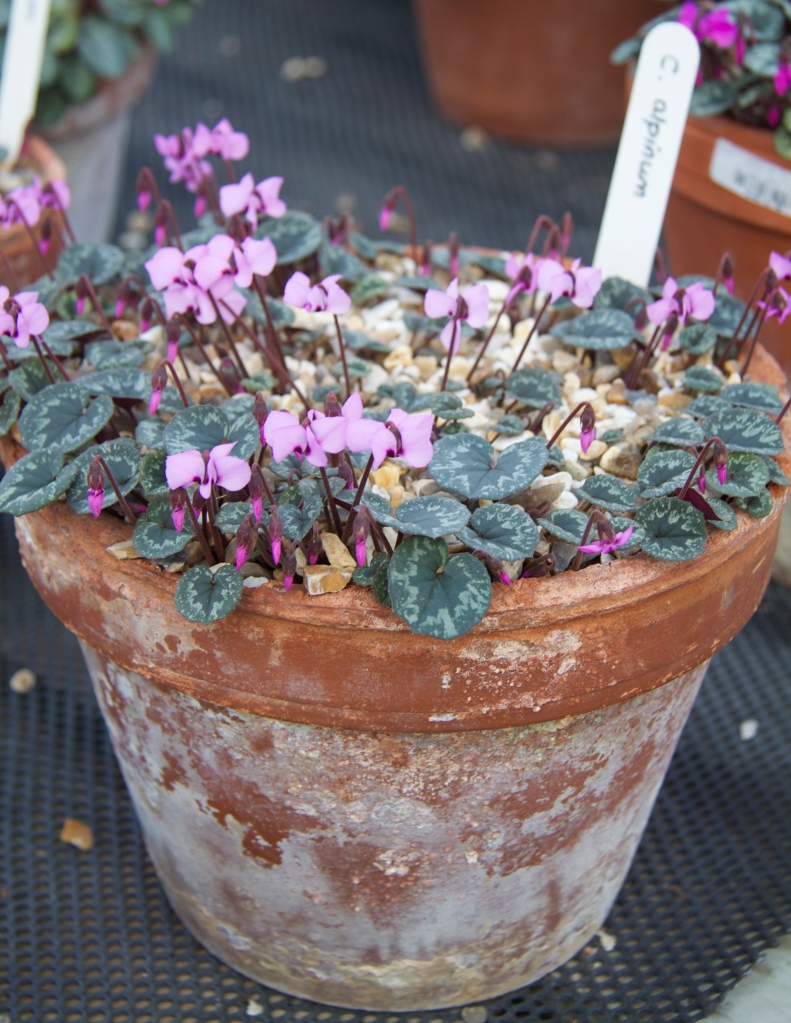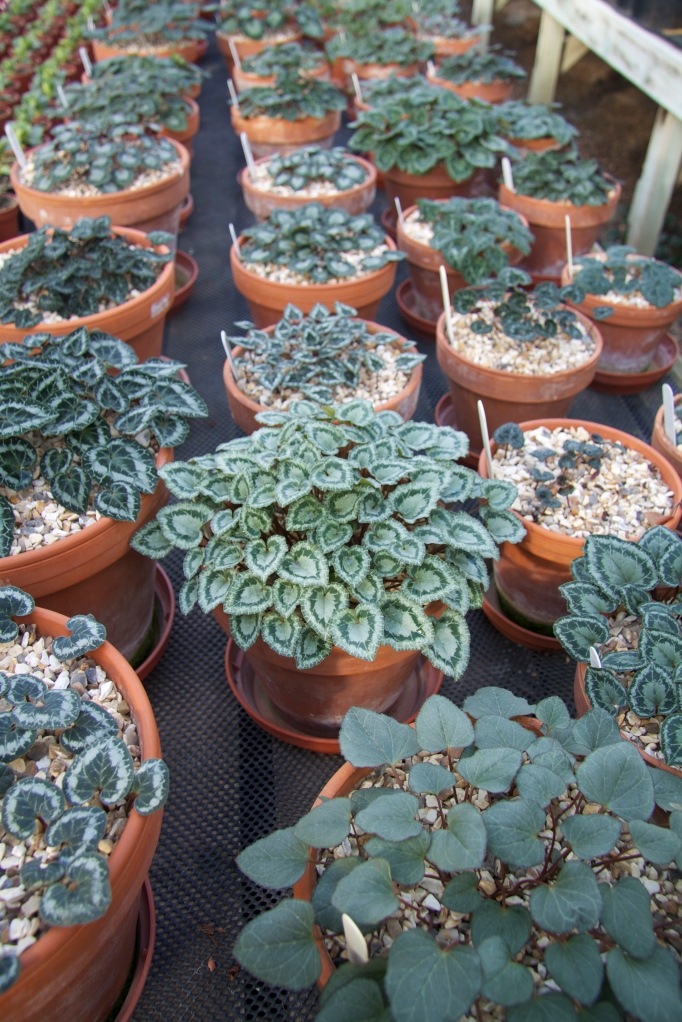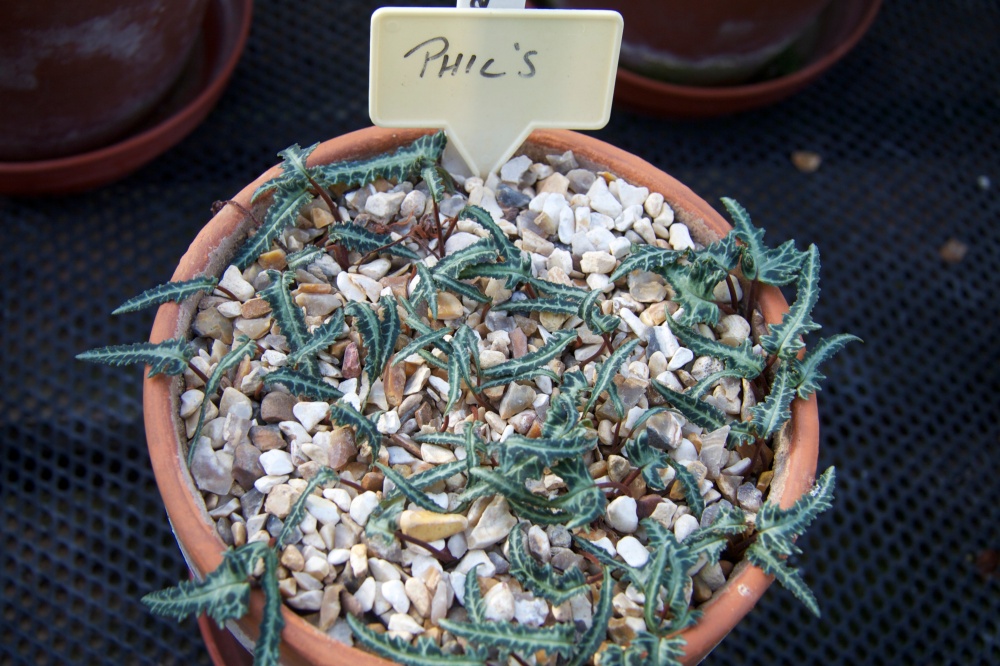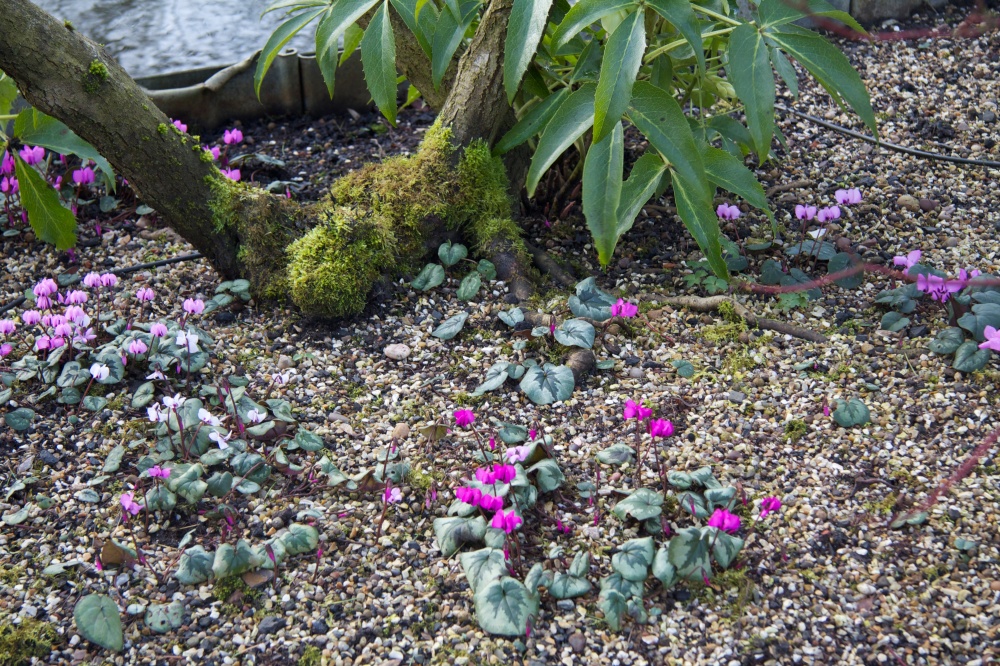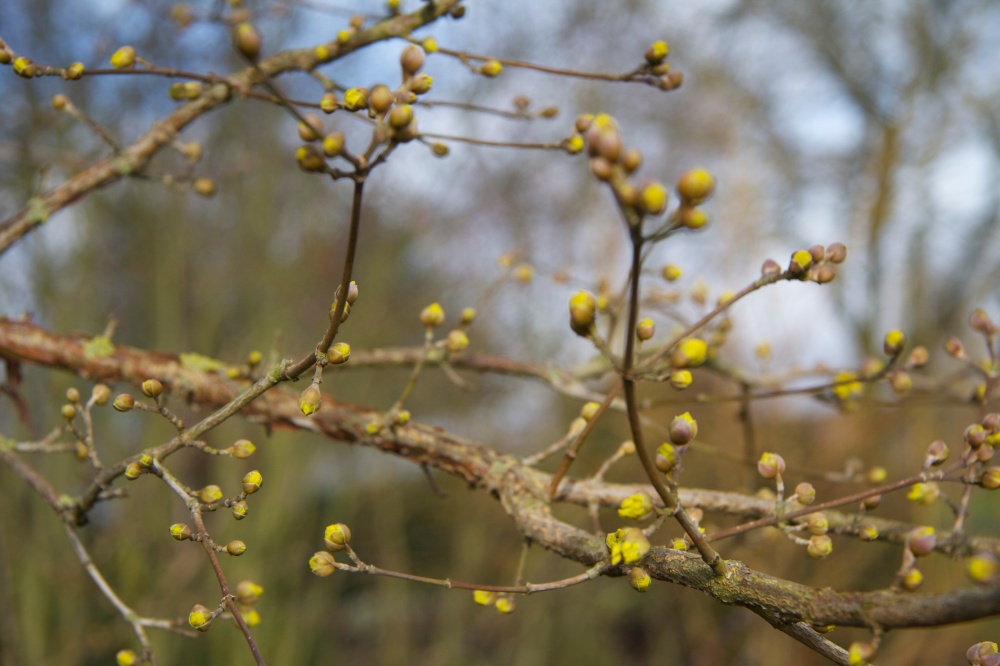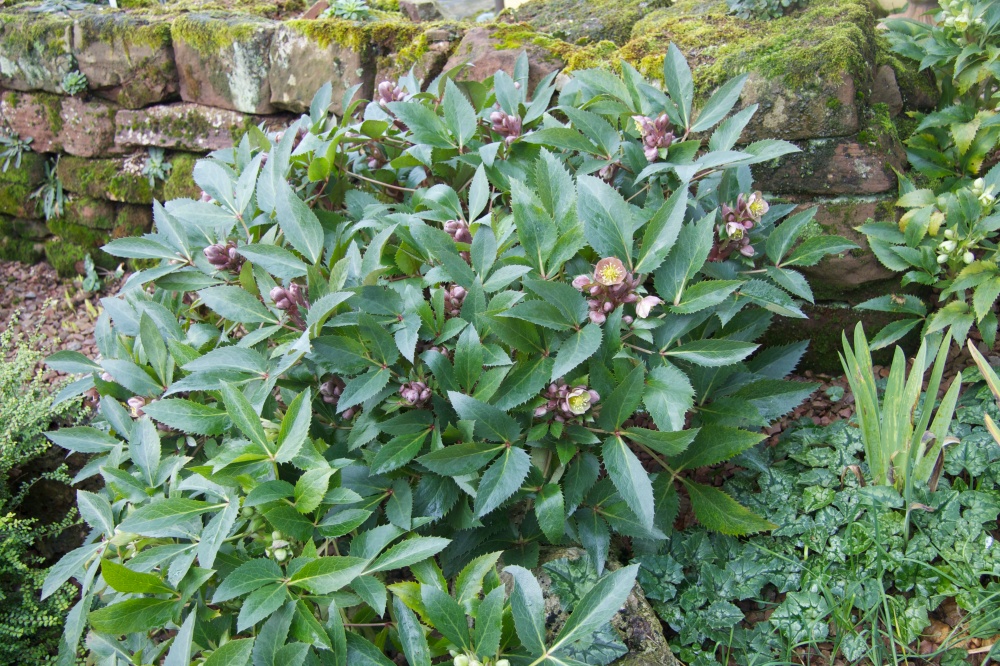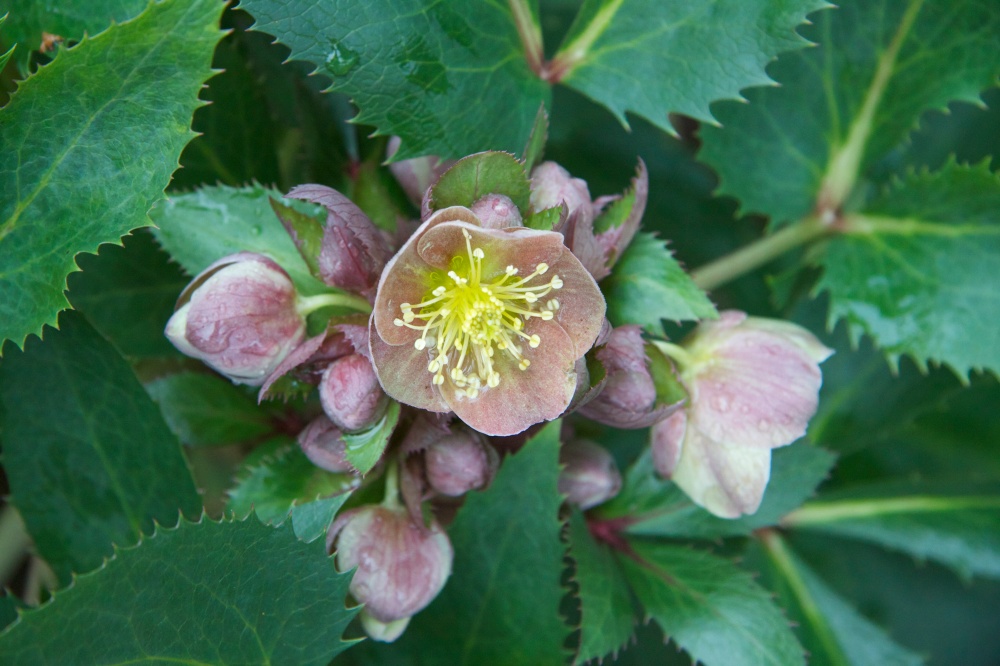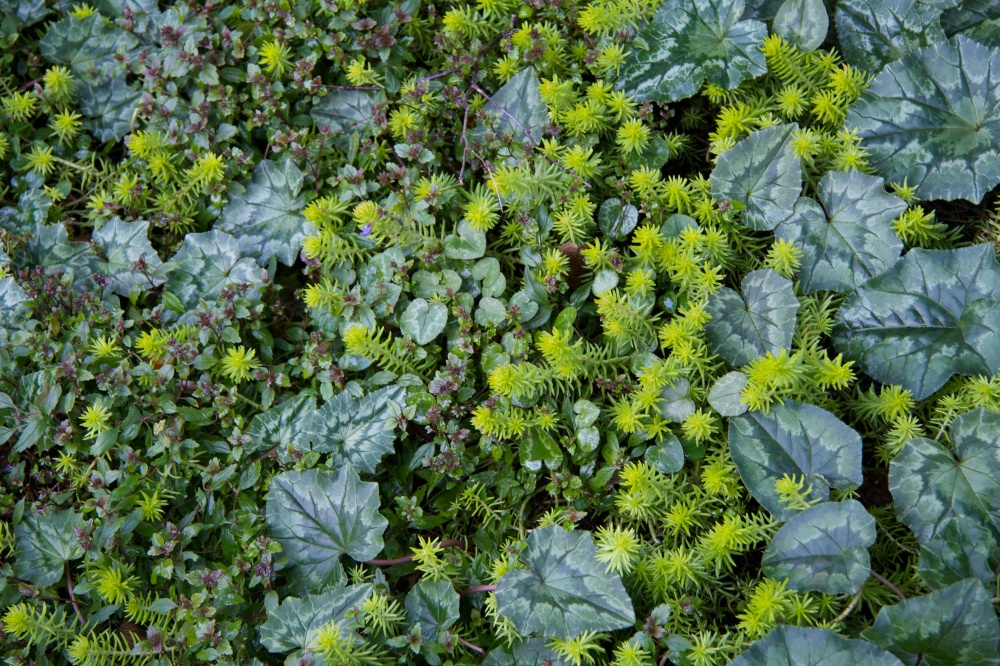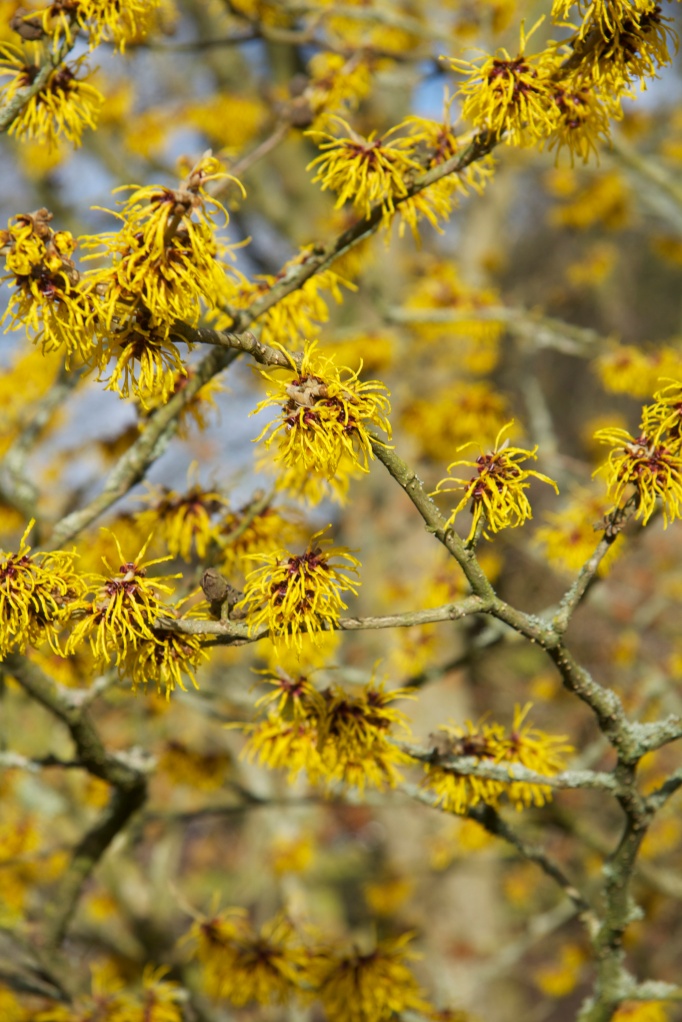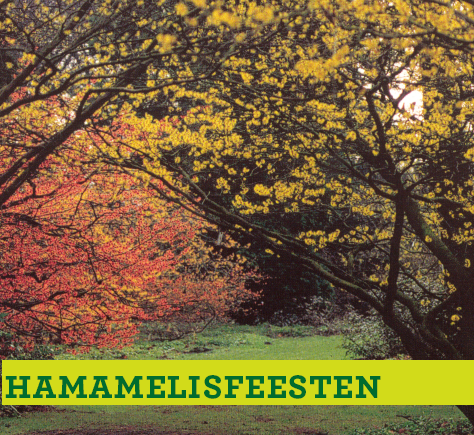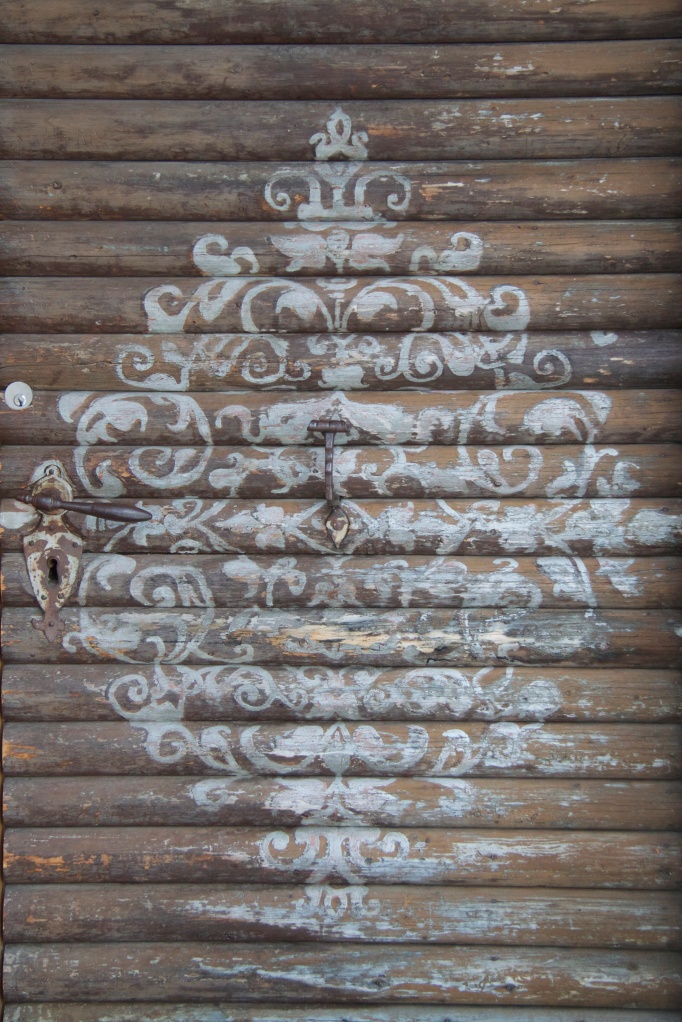MY TWO FAVOURITE SUFFOLK GARDENS READY FOR SPRING
 Milky blue painted seat with Madonna and Child at Wyken Hall Gardens
Milky blue painted seat with Madonna and Child at Wyken Hall Gardens
We have just returned from a week of extraordinary snow in our favourite mountain village of Gargellen, Austria:
Arthur and a fruit tree under heavy snow in Gargellen, Austria
At times the only way to track down a faint whiff of spring was to indulge in a little medicinal yet subtly fragrant Gentian root schnapps:
Enzian or Gentian root schnapps
Back in Suffolk for an Easter holiday weekend and things are beginning to warm up. I grab the chance to sneak off to my two favourite Suffolk gardens, Wyken Hall and Fullers Mill.
I head first to our near neighbours at Wyken Hall. Here Sir Kenneth and Lady Carla Carlisle have created a richly coloured, welcoming homestead. They have developed a wonderful garden around their intensely copper-red limewashed Elizabethan Manor house, planted a productive vineyard and converted elegant barns into The Leaping Hare restaurant and stores – they also host a first class farmers’ market every Saturday morning. This is a place where careful thought, dextrous – sometimes daring – use of colour, and great style infuse every garden path, view and would-be naked gable end. Even the sign to the car park is richly painted with a velvety palette of plants to match:
The garden itself can be visited every afternoon except for Saturday until the autumn. 
From the moment you approach the house, the deep ‘Suffolk Pink’ of its walls and the series of blue painted rocking chairs under espaliered crab apples – the rocking chairs an echo of the verandahs of the Southern States of America where Carla Carlisle was brought up – create a wonderful sense of welcome.
I love the almost dangerous choice of bright red Chaenomoles (ornamental quince) against the red limewash and the way the strong colour of the house enables even the dusty winter-pruned lavender to work a sort of silvery magic at this spare time of year.
Red Chaenomeles and pruned lavender against rich Suffolk Pink walls
By early summer no tricks will have been missed – electric blue ceanothus will be adding another layer of colour:
 Electric blue Ceanothus adding another layer of colour, Wyken Hall, May 2010
Electric blue Ceanothus adding another layer of colour, Wyken Hall, May 2010
As you make your way around the garden you pass through a small courtyard with a beautiful old copper container at its centre. Every element of this space is suffused with the same rich, moody palette. The aged verdigris container contrasts with yellow and royal purple of Viola tricolor which sings out between the tulip leaves. In the border, the pale blue of forget-me-nots and the clear pinks of Cyclamen coum act as exquisite highlights to the soft red and darkest purple-black of the hellebores, and on the wall leading to the orchard sits a peacock, a swoop of rich green and blue.
 Viola tricolor amongst tulips in copper urn
Viola tricolor amongst tulips in copper urn
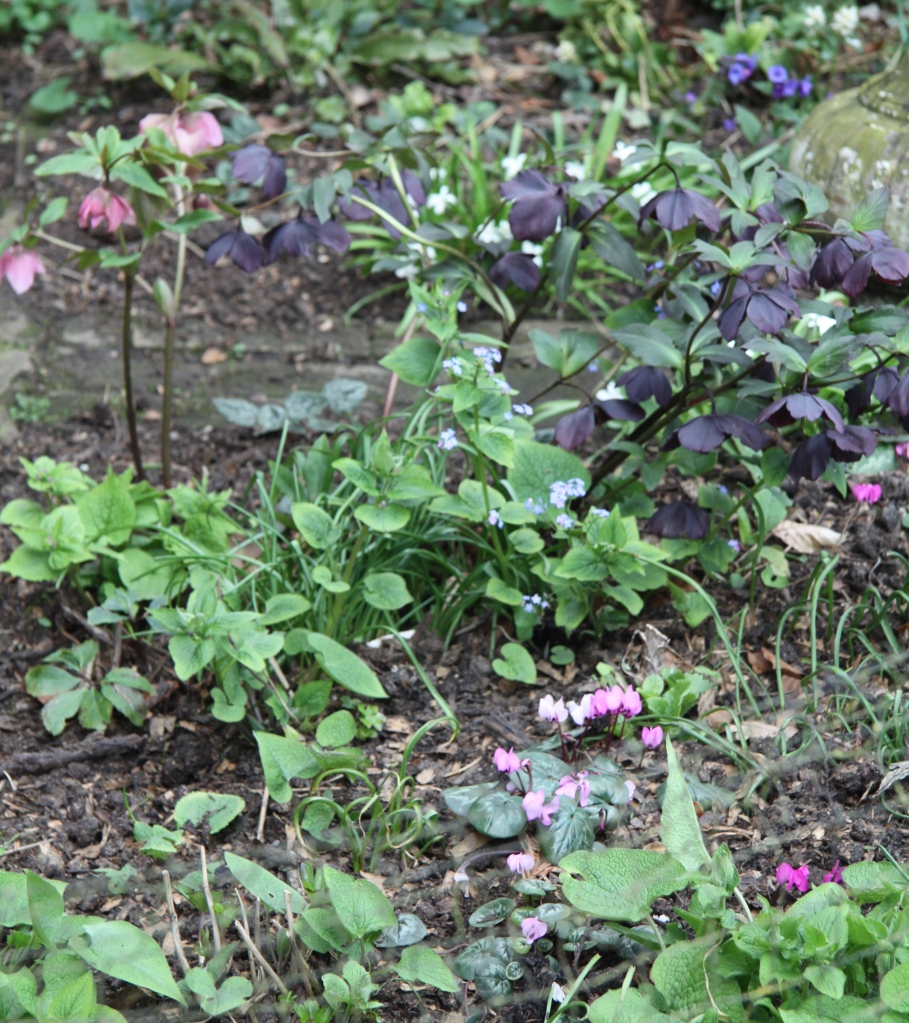 Hellebores, forget-me-nots and Cyclamen coum
Hellebores, forget-me-nots and Cyclamen coum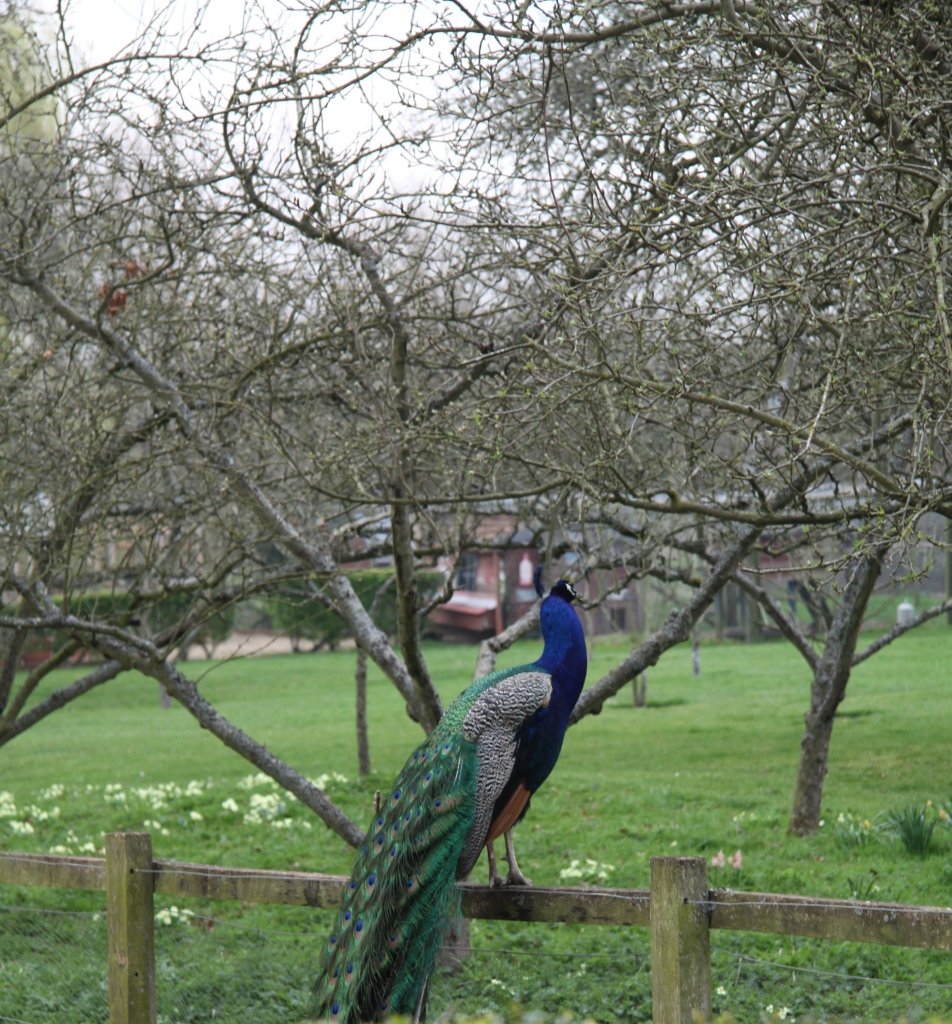 Peacock contemplating the orchard, Wyken Hall
Peacock contemplating the orchard, Wyken Hall
As you enter the Hot Border – there is just a small taste of the outrageous colour to come – neighbouring stands of brilliant ‘Orange Emperor’ tulips and even deeper orange crown imperials – Fritillaria imperialis – brilliant against the smooth dark green of the clipped yew hedge.
‘Orange Emperor’ tulips and Fritillara imperialis against a clipped yew hedge
Looking back an the house the acid green of Euphorbia characias contrasts almost as vividly with the more demure planes of yew and box:
Euphorbia characias with box and yew hedging
In every direction the views are strongly framed:
 Yew and box frame the view to the woodland beyond
Yew and box frame the view to the woodland beyond
Or there is a strong simple idea – such as these espaliered pear trees against a brick and flint wall underplanted with a stretch of iris…
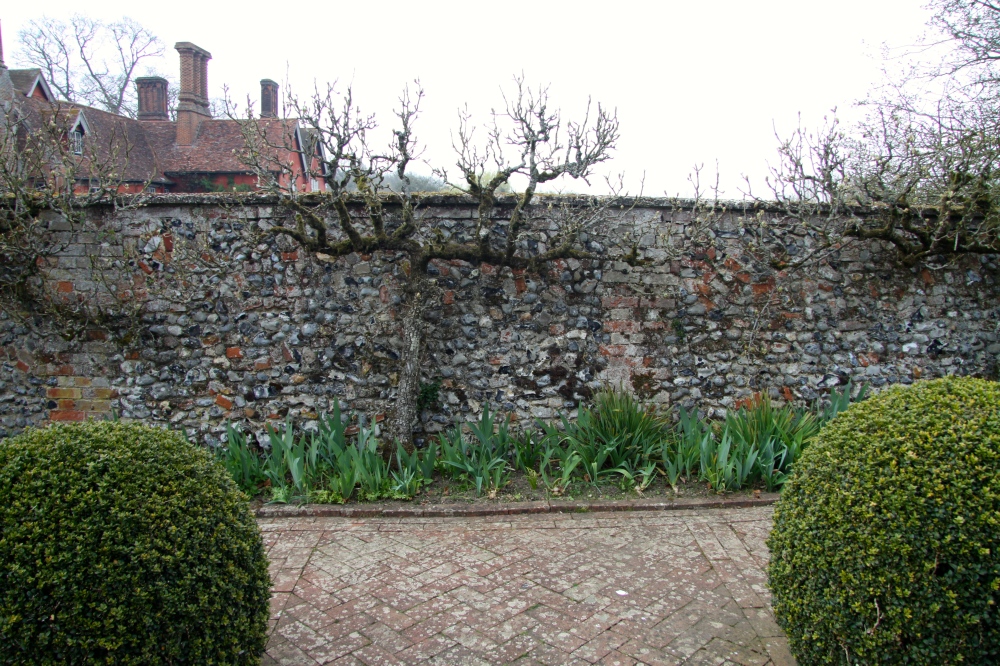 Espaliered pear underplanted with Iris
Espaliered pear underplanted with Iris
…and one more example of a wonderful, inventive gate – I love this simply made, Art Deco inspired stepped wooden gate revealing the life of the field beyond:
Around the house is a series of intricately laid out rooms – originally designed with the help of Arabella Lennox Boyd. A pair of impressive standard white wistera with fattening buds provide substance and energy amongst the clipped topiary of the Knot garden, even this early in the season:
 Pair of standard white wisteria and fattening wisteria buds
Pair of standard white wisteria and fattening wisteria buds
It won’t be long before this garden room is alive with both white and mauve wisteria:
Vintage Wisteria at Wyken Hall – May 2010
As the afternoon begins to cool off, the next garden room, with four standard viburnum as centre pieces, is looking sober and beautifully ordered. Even the lichen on the brick is an extra, gently decorative layer:
 lichen on diamond- pattern brick terrace
lichen on diamond- pattern brick terrace
The garden at Wyken Hall is a masterclass in creating a sense of comfortable enclosure and making sure that every place to sit feels inviting. This bench nestles between generous shapes of topiaried box and a pair of neatly pruned weeping silver pear, Pyrus salicifolia pendula.
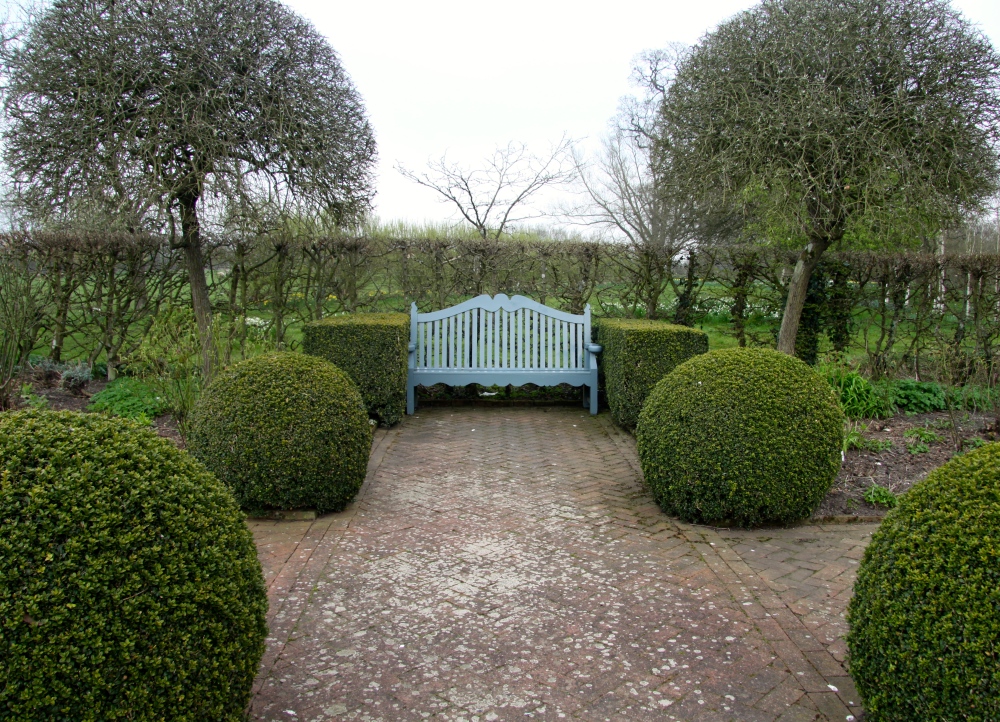 Painted bench looking settled between topiaried box and weeping silver pear trees
Painted bench looking settled between topiaried box and weeping silver pear trees
Another old – rather pink-tinged! – photograph this time from 2004, gives an idea of how bright and full this scene becomes later in the year:
In the cottage garden a friendly bench is placed invitingly beneath a window and at the end of the central path which leads through the front garden which is about to become a sea of colour:
Centrally placed bench, cottage garden
At another point around the main house, a table and pair of chairs look settled – where they might have felt a little lost and wrong in scale – positioned with the neat rectangle of clipped yew and wavy, bright gree hedge of Hebe as a backdrop and further anchoring device:
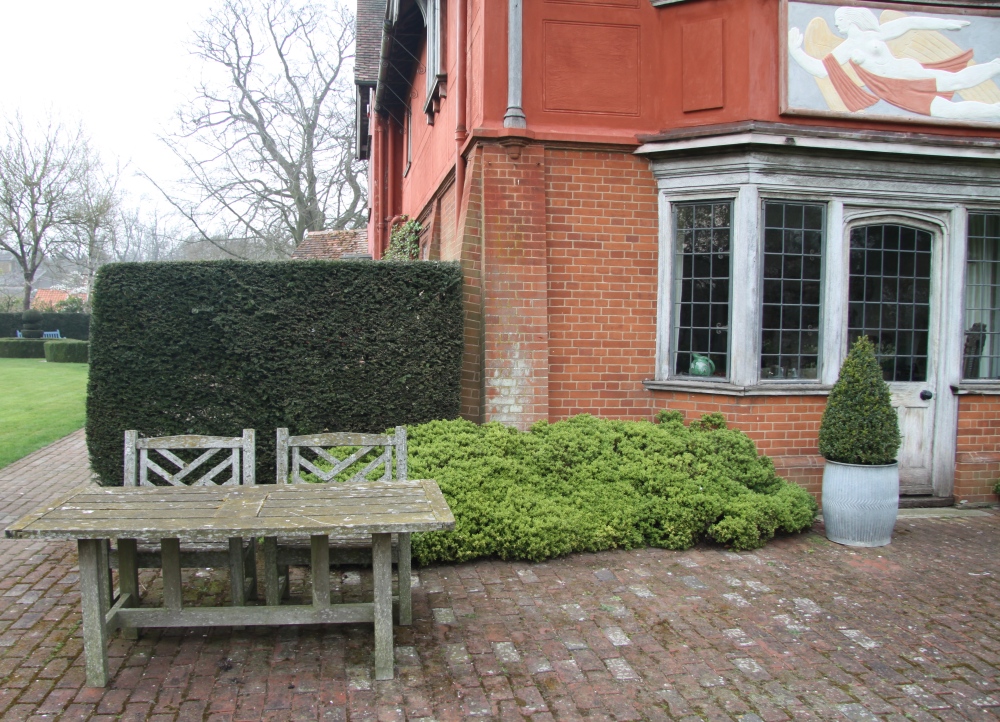 Table and chairs with yew and hebe as backdrop
Table and chairs with yew and hebe as backdrop
There is a celebratory quality to much of the garden – a very pretty pergola of trained fruit trees is underplanted with starry blue Chionodoxa – I think Chionodoxa luciliae –

 Pergola underplanted with chionodoxa
Pergola underplanted with chionodoxa
There is a double gate leading invitingly to the pond just beyond the rose garden with its welcoming Adirondack chairs and framed pontoon. Rummaging again through my boxes of garden photographs I smiled when I found this image of ten year younger husband, Nick, (funnily enough, mid very long work phone call …), sitting on the pontoon in all its gorgeous full summer splendour.
Pontoon and pond at Wyken in April 2015 and below in August 2004
Walking back to the front gate the garden opens out onto a quite splendid oak tree with a sea of cheerful narcissus lighting up the scene
A path cut through this spring flowering meadow takes you to a half hidden glade with an arched seat painted in the same milky blue as much of the other garden furniture – this time with an inset panel of Madonna and child.
 Path through spring flowering meadow
Path through spring flowering meadow
 Arched seat with Madonna and Child panel
Arched seat with Madonna and Child panel
The entrance to the glade is formed entirely and unashamedly of intensely scented winter/early spring flowering trees and shrubs – Lonicera x purpusii ‘Winter Beauty, Sarcococca confusa and a pink flowered Viburnum – (surely ‘x Bodnantense’ which would be entirely fitting as Kenneth was born and brought up in the wonderful house and famous garden at Bodnant in Conwy, North Wales). I love the way the artfully broken path leading to the seat is scattered with jewel-like, navy blue muscari, more chionodoxa and delicate sheaves of pale narcissus.
The entrance to glade is framed by scented shrubs
The broken path is strewn with sheaves of pale Narcissus
The garden at Wyken is a modern country garden with a now mature structure which acts as a fine backdrop to seasonal planting as it emerges throughout the year.
Beyond the garden, the shop and farmers’ market provide equally tempting seasonal delights and a chance to admire the most magnificent stretch of immaculately pruned and wall-trained figs.
 Autumn pumpkin display at Wyken
Autumn pumpkin display at Wyken
I visit my other favourite, old friend of a Suffolk garden, Fullers Mill, the following morning.
 Path through The King’s Forest, leading to Fullers Mill Garden
Path through The King’s Forest, leading to Fullers Mill Garden
Fullers Mill near Bury St Edmunds is only about twelve miles away from Wyken. It is a completely different style of gardening and inspiring for its passion for nature and for its fascination with each individual plant.
You approach this extraordinary 7 acre garden along a track through the King’s Forest. If you hit the right moment in June this part of the forest is waist high in shocking pink and purple foxgloves – and that is before you even arrive at Fullers Mill:
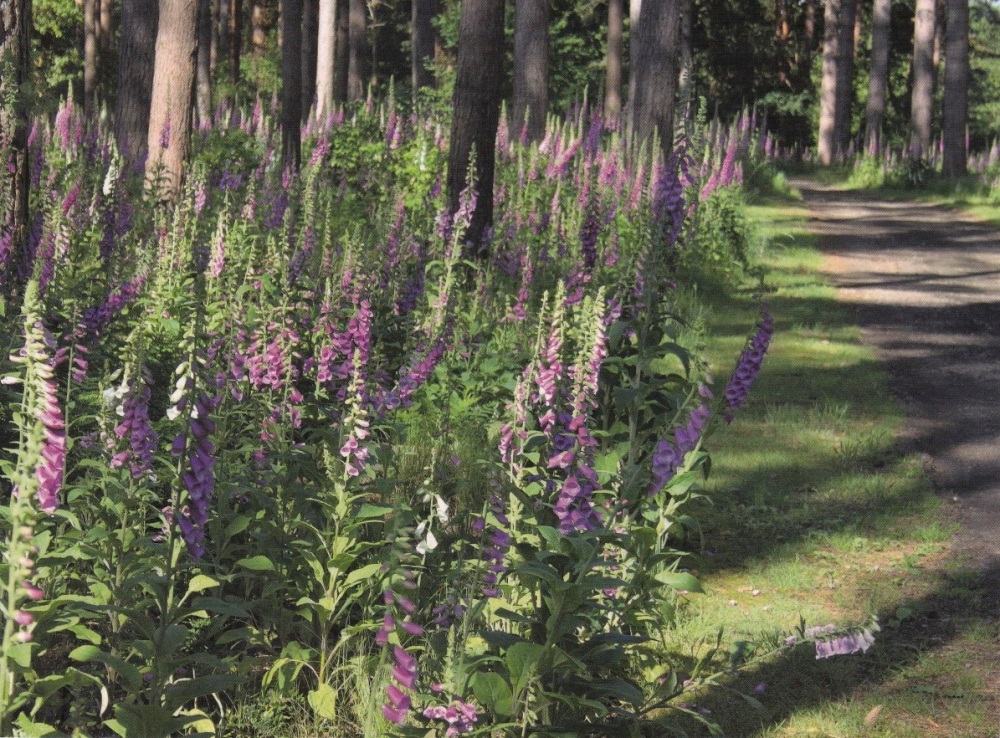 The forest path waist-high in foxgloves
The forest path waist-high in foxgloves
Hidden away at the end of the path is an incredibly peaceful and very personal garden which has been carved out of not always hospitable soil around a mill house for over fifty years by Bernard Tickner. Bernard, nearly 91, has now given the garden to the charity Perennial but still lives there and with their help is still caring for – indeed still extending and improving – the garden.
Bernard Tickner on his almost daily round of Fullers Mill Garden
A passionate plantsman, Bernard still exchanges plants annually with his long-standing and much revered friend, Beth Chatto and over the years devoted as much time as he could away from his job as Head Brewer for Greene King to travel to Crete and the Pyrenees to seek out plants in their natural habitat. Years ago, renowned botanist John Raven – father of Sarah Raven – offered guidance as to the cleverest places to visit. Bernard has a Pyrenean fritillary named for him and in the shelter of a small private courtyard by the mill house itself is a tiny Cretan Iris named for his late wife, Bess.
On this early April morning, the garden is looking immaculate and fresh, with swathes of gentle red hellebores threading their way through the softly mulched space and the the acid yellow-green of Euphorbias catching the cool spring light:
Bernard and I set off around the garden together. We stop first at a sheet of naturalised Narcissus bulbocodium :

 Narcissus bulbocodium, Fullers Mill
Narcissus bulbocodium, Fullers Mill
Bernard is proud of his ever expanding display which started of as four or five small pots – this six by six metre patch has been encouraged by sowing yellow rattle to weaken the grass.
One of my favourite things about the way the garden at Fullers Mill has developed is that there is real space for plants to spread and be themselves. There is magnificent witchhazel for January and February, as elegant as a movie star in a cool skirt of snow and later flowering at full blast:
Spreading Witchhazel at Fullers Mill
Today a mature Magnolia x loebneri ‘Leonard Messel’ lights up the woodland with its pale pink starry flowers. Under the magnolia, a large pool of the woodland dicentra, Dicentra formosa, is given space to thrive.
Magnolia x loebneri ‘Leonard Messel’ underplanted with Dicentra formosa
Everywhere there are treasures to discover. Here a text-book healthy clump of Arum creticum with clear yellow spathes and long yellow spadices:
Arum creticum
Close by there is a patch of lovely, pointy–flowered Tulipa sylvestris :
Tulipa sylvestris
and not far away a patch of the creamy yellow fritillary, Fritillaria pallidaflora:
There is a wonderful specimen of the tree heather, Erica arborea var. alpina whose long, fragrant candle-like panicles make softly energetic patterns:
We pass under an enormous, tunnel-forming Cornus mas. Even now, as its flowers lose the intensity of their yellow, the branches look fresh and pretty as they hang over the millpond in the spring sunshine:
And the still tiny leaves of the Cercidiphyllum japonicum – which will smell of toasted sugar in autumn – catch the light like hundreds of coins.
There is a lovely area of Fritillaria meleagris too:
” I don’t know why they call it the snakeshead fritillary’ remarks Bernard “‘meleagris means spotted like a guinea fowl”. A fair point.
By midsummer, today’s clump of exquisitely pleated leaves of Veratrum nigrum will be the base of statuesque flowerheads:

Veratrum nigrum leaves then flower
And the garden will be shoulder-high with a dazzling collection of lilies. “They are not as difficult to grow as people might think”, sighs Bernard. As always with him it is a question of growing the right plant in the right place. “What they should shout from the rooftops is ‘good drainage!’ ” he cries out in his inimitable part deadly serious, part playful manner.
Bernard Tickner amongst lilies, and lilies and campanula at Fullers Mill
Before I leave, I photograph Bernard next to the stand of plants for sale. There is a new polytunnel in the garden and an exciting new commitment to propagate and sell as many plants as possible from the garden. Fullers Mill is open to the public on Wednesdays, Fridays and Sundays, 2 – 5pm until the end of September. The quality of the coffee and walnut and lemon drizzle cakes goes without saying.
Bernard Tickner with plants for sale from the garden.

















